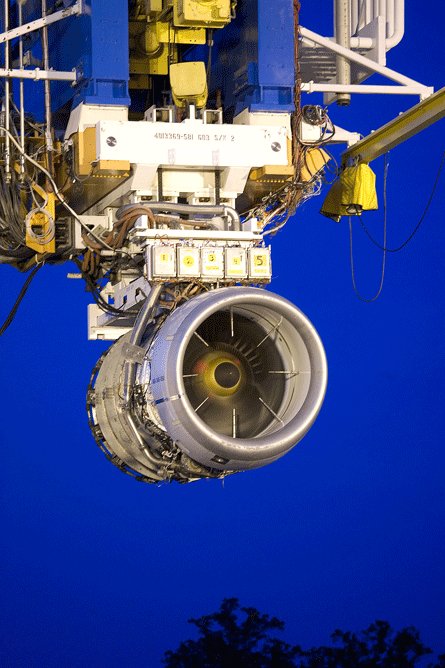A race to bring new technologies to market is keeping engine manufacturers busy in a down airline economy.
GE is working on several continents testing cores and blades for its next-decade and beyond Leap X designs, while Pratt & Whitney has begun procuring long-lead parts - bearings and castings - as it prepares to begin testing the first prototypes of its advanced-technology PurePower geared turbofan engines for the Bombardier CSeries and Mitsubishi MRJ regional jet.
Paul Adams, P&W's senior vice-president of engineering, says many of the detailed designs for the 20,000-24,000lb-thrust (89-107kN) class CSeries engine have been completed, allowing the hardware manufacture to begin. Some design work continues, however, and will culminate in a critical design review in early 2010. Adams says the first core tests will take place this winter, following by full-up engine runs for the PW1500G next summer.
Work on the lower-thrust PW1217 for the MRJ has been pushed back because of Mitsubishi's redesign of the aircraft, which includes using aluminium instead of composites for the wing.
Adams does not expect changes to the aircraft to affect the engine, which will enter the detailed design phase by year-end, start production in the second half of 2013, and go into service in 2014. PW1200 series engines will produce 13,000-17,000lb thrust.
Adams says the final bypass ratio for the PW1500G engine will be in the "10-plus" range. P&W has advertised a 12:1 bypass ratio, which could decrease fuel burn by as much as 15% compared with similar engines.
 |
|---|
© General ElectricCFM began testing its first Leap X core in June |
GE and Snecma joint venture CFM is marketing a 16% reduction in fuel burn with its advanced-technology Leap X ducted turbofan. A CFM56 follow-on, it is expected to run for the first time in 2012 and receive certification by 2016.
"All the studies we have done with airframers show a bypass ratio of 10:1 to 11:1 as the optimum for a next-generation single-aisle type of airframe," says Ron Klapproth, Leap X programme manager. "That's a parameter that is optimised at the airplane level. The engine gets more efficient with higher bypass, but what really counts is airplane-level fuel burn."
CFM says the ducted-fan version of the Leap X will have a bypass ratio of 10:1. The company is also researching an open-rotor version that would not be ready for service until after 2020.
CFM began testing its first Leap X core in June, clocking 100h of ground tests with the combustor and single-stage high-pressure turbine (HPT). A second round of tests will begin on the compressor section later this year, while the company develops, in parallel, a second core with two-stage HPT. Klapproth says CFM has "a couple of years" before it must decide which configuration to use for the new engine.
"We are very pleased with data on the combustor and HPT," he says, adding that the performance, airflow and acoustics matched what was expected from component level testing over the past few years. CFM also plans to begin endurance testing of the composite fan blade for the engine later this year.
For the open-rotor engine, the company is set to begin windtunnel testing on various composite blades in the USA, France and Russia. CFM says a 4.3m (14.1ft) open-rotor fan could deliver a 26% reduction in fuel burn, although mounting could be an issue, as well as airline acceptance of a radical design.
Source: Flight International



















